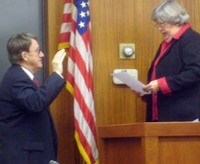
Four Public Unions Settle with North Adams
 |
| City Clerk Marilyn Gomeau gives the oath to newly re-elected Council President Alan Marden. Top photo, she gives the oath to Vice President Richard Alcombright. |
Mayor John Barrett III on Tuesday night presented the City Council with the final amendment for a two-year contract with Teamsters 404, representing employees in the Department of Public Works, that was reached before Christmas.
The contract includes a 2 percent increase retroactive to last July; 1 percent as of Jan. 1; 2 percent as of this coming July and another 1 percent a year from now.
Barrett said the city had also reached contracts with locals within the school systems representing paraprofessionals, assistants, janitors and other staff.
"I made a last-ditch effort with the Public Works group as I did with all the others, and the remaining that didn't settle, that without a settelement the prospect of retroactivity would be off the table," the mayor told the council. "And even with [the retroactive raise] there's a price to pay for it."
Two positions will not be filled to help pay for the cost of the raises; with more retirements on the horizon, that number could rise if economic factors continue to worsen. "There's absolutely no money to spare," he said.
The unions representing the police, fire and teachers have not settled with city; like the Teamsters, their contracts ran out Dec. 1.
All seven unions had banded together in an effort to push the city into signing onto the state's Group Insurance Commission, which was opened to municipalities and other governing bodies to help them deal with rising insurance premiums.
The union's leadership said joining GIC, which covers more than 200,000 state workers, would save the city $1.5 million; the mayor disputed the amount, saying the unions' study had failed to list a more expensive plan comparable to the current one offered and that GIC was already mulling a rise in rates.
Barrett said the Teamsters, alone of the unions, were smart to sign a two-year contract in light of looming cuts in the city's revenue.
The city could lose $1.5 million to $2 million in state funds, or more if Gov. Deval Patrick is given so-called "9C" powers to slash budgets. Barrett said he planned to join other mayors from around the state in Boston on Thursday for Patrick's State of the State address.
"Needless to say, we're headed for some tough times," he told the council, after stating: "Our workers are not the highest paid in the world but I don't think they should go without, and they are not the greatest increases but they're going to get something."
The council passed the amendment to a second reading with no discussion.
The councilors also:
The city's unions are the North Adams Teachers Association; the North Adams Paraprofessionals; the North Adams Police Association, Local 382; IAFF, Local 1781 representing North Adams Fire Fighters; Teamsters Local 404 representing employees of the Department of Public Works; the North Adams Teachers Assistants Association; and AFL-CIO 204 State Council 93, American Federation of State, County and Municipal Employees/City of North Adams.















